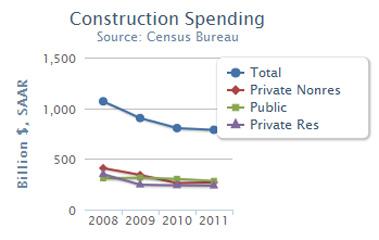Construction has mixed impact on first-quarter GDP; AIA, NABE surveys point to upturnEditor’s note: Construction Citizen is proud to partner with AGC America to bring you AGC Chief Economist Ken Simonson's Data DIGest. Check back each week to get Ken's expert analysis of what's happening in our industry. Real (net of inflation) gross domestic product (GDP) increased 2.5% at a seasonally adjusted annual rate in the first quarter of 2013, after growing 0.4% in the prior quarter, the Bureau of Economic Analysis (BEA) reported on Wednesday. Real private investment in nonresidential structures (including wells and mines) slipped 0.3%, after jumping 17% in the fourth quarter. Real residential investment climbed 13%, following a 18% gain. Real government investment in structures shrank for the 10th consecutive quarter, at a 5.6% rate, following a 2.6% decline. The price index for private nonresidential structures posted a 1.5% increase at a seasonally adjusted annual rate, similar to the previous quarter’s 1.4% rise. The price index for residential investment accelerated to 5.2% from 3.0% as strong demand from single- and multifamily builders pushed up prices for homebuilding materials. The price index for government investment rose at a 2.3% rate, up from 1.7%.
Reshaping the Construction Industry


Last month some high school students attended a drywall installation clinic at Pasadena ISD’s L.P. Card Career and Technical Center led by a team from the Houston division of Marek Brothers Systems. The team from Marek – which included Saied Alavi, Terry Holcombe, Dave McMillan, Buddy Britt, and Aurelio Flores – gave a classroom presentation to the two dozen students in Pasadena, Texas before leading them in a hands-on workshop where they shared their experience and crafts knowledge with the students.Saied Alavi began with an introduction, giving a little background information about Marek Brothers Systems. He talked about the opportunities individuals coming out of high school can find at Marek, and the wage level and potential for career growth they could expect. He explained how those who stay with the company have opportunities to move up to become a supervisor, a foreman, or even a superintendent – it is up to each individual how far he or she can move up the company career ladder. He stated: “We don’t choose anyone by their height, by their size, by the color of their hair – it’s all based on your work. It’s an open race. Just as in track and field, when everybody lines up, it all depends on who runs the fastest. In Real Life it is the same way.
April 29, 2013


The Houston/Gulf Coast Chapter of the Society of Office and Industrial Realtors (SIOR) held its 30th Annual Expo in Houston recently. Almost 500 brokers, developers, contractors, vendors and suppliers attended the Expo and the developer panel titled, Developing Houston 2013.I was honored to moderate this panel of major developers and to ask them questions about their current and planned projects as well as the current market conditions in the other cities where they have projects underway.The panel was comprised of four panelists:
April 26, 2013


The Construction Career Collaborative (C3) recently held a Sponsors’ Meeting to provide an opportunity to update supporters on progress made toward advancing the principles of C3.Jim Stevenson, Chairman of C3, provided some highlights of accomplishments to date. These include:Enlistment of two Beta Project Owners – Texas Children’s Hospital and MD Anderson – involvingFour ContractorsNumerous Specialty ContractorsHundreds of Craft WorkersDevelopment of a toolkit for participantsAn application for accreditation (under development)Development of an online C3-5 Safety TrainingQualification of 46 Safety Trainers at 23 companiesDevelopment of a job description and funding model through a loaned staff memberPreparation of By-Laws and Policies in order to file as a 501(c)(3) organizationContinued spreading the word to add other project OwnersIn addition, the C3 Marketing Committee members, John Stautner and Michele Buckingham, facilitated a discussion with sponsors on ways in which C3 supporters might engage and participate in advancing C3 principles to their members and to the community.
April 24, 2013


The lawmaker who had filed a bill to ban "living wage" ordinances around Texas has decided that was a bad course of action. Representative Kenneth Sheets, R-Dallas, withdrew his bill after hearing objections from Republicans and Democrats alike.Some on the left argued it was "draconian." This is from the liberal Burnt Orange Report:"The draconian bill was aimed at metropolitan areas such as San Antonio and Travis County, where living wage agreements are already on the books. The Austin City Council is considering one that would be added to economic incentive packages. These agreements require projects to pay a living wage to construction workers if they are receiving incentives.Basically, Sheets doesn't think that local governments should have the control to use their tax dollars in support of their community values. Sounds just a bit like that "Big Government" Republicans are always railing against."
April 23, 2013


The team at Software Advice in Austin has just released its 2013 Construction Project Management Software Benchmark Report. The report turned up some interesting information that you should consider when you are looking at your construction management software needs.The report looks at four categories of users in the sample – Specialized: Project management software designed specifically for the construction industry.Generic: Software designed to handle general project management needs.Homegrown: Custom software built from the ground up for the survey participant.Manual: No software; projects are managed using email, fax, phone or other manual means.According to the team, “Our report – based on a survey of 230 construction professionals – surfaces important findings about the role technology plays in construction project management. For instance, we found that individuals who use construction-specific project management software were 5 times more likely than custom software users to deliver their projects under budget.”
April 22, 2013


More than half of states add construction jobs in March; Reed, MHC differ on startsEditor’s note: Construction Citizen is proud to partner with AGC America to bring you AGC Chief Economist Ken Simonson's Data DIGest. Check back each week to get Ken's expert analysis of what's happening in our industry.Click here to view March state employment numbers.In March, seasonally adjusted nonfarm payroll employment increased from a year earlier in 49 states and the District of Columbia and dipped by 0.1% (5,800 jobs) in Pennsylvania, the Bureau of Labor Statistics (BLS) reported Friday. Seasonally adjusted construction employment climbed in 31 states and the District of Columbia and fell in 19 states. Alaska had the largest percentage increase (11.4%, 1,900 jobs), followed by Hawaii (10.7%, 3,100 jobs), Utah (8.7%, 6,000 jobs) and Louisiana (8.6%, 10,700 jobs), AGC reported. California added the most new construction jobs over the past 12 months (41,000, 7.1%), followed by Texas (39,800, 6.9%). Rhode Island lost the highest percentage (-9.6%, -1,600 jobs), followed by Montana (-8.1%, -1,900 jobs).
April 22, 2013


A federal grand jury in Kansas City, Kansas has charged a construction company, its owners, and four of its crew leaders with harboring illegal aliens and money laundering, charges which could bring the defendants up to 20 years in federal prison each and fines up to $250,000 per convicted count. Advantage Framing Systems, Inc. of Spring Hill, Kansas, company owners James and Kimberly Humbert and Charles Stevens II, and four framing crew leaders for the company – Jose Ramon Caro-Corral, Angel Arguello-Plata, Dennis Ericson Portillo and Jorge Uriel Delgado-Ovalle are all charged with committing these crimes as part of a scheme to hire illegal workers in order to gain a competitive advantage over other contractors and boost their own profits.A press release by the United States Attorney’s Office for the District of Kansas explained how the company allegedly conducted business:“The indictment alleges James Humbert, Kimberly Humbert, Charles Stevens and the company itself were responsible for hiring undocumented workers for the purpose of lowering the company’s operating costs. The wages the company paid did not include the employer’s share of Social Security payments, workers compensation, or unemployment insurance benefits paid to lawfully employed workers in the construction industry. They placed themselves at a competitive advantage to other builders who did not employ undocumented workers.
April 19, 2013


All human beings, by nature, have a desire to know.So, in the grand scheme of things, does holding a college degree really matter for a prosperous career? How about a willingness to learn a skilled craft or trade in the construction industry?A recent New York Times article entitled “It Takes a B.A. to Find a Job as a File Clerk” identifies an employment trend stating a college degree is the new minimum requirement for getting even the lowest-level white collar jobs, which do not require college-level skills.According to the article, economists have referred to this phenomenon as “degree inflation,” and it has been steadily infiltrating America’s job market. Across industries and geographic areas, many other jobs that didn’t used to require a diploma — positions like dental hygienists, cargo agents, clerks and claims adjusters — are increasingly requiring one, according to Burning Glass, a company that analyzes job ads from more than 20,000 online sources, including major job boards and small- to midsize-employer sites.The author states “up-credentialing” is pushing the less educated even further down the food chain, explaining why the unemployment rate for workers with no more than a high school diploma is more than twice that for workers with a bachelor’s degree: 8.1 percent versus 3.7 percent. Yet, the U.S. is facing a skilled workforce shortage in construction and there are many jobs available for those with high school degrees who are willing to work.
April 18, 2013


Major Texas homebuilders came out against the state's moves toward cracking down on worker misclassification during a legislative hearing on Wednesday. The Leading Builders of America, which represents Perry Homes, David Weekley Homes, and others, argued that putting new regulations in place for the industry would lead to higher home prices and stifle job creation.Steve Henry, speaking for the Leading Builders of America, the trade group that represents Perry and Weekley, said the crackdown on payroll fraud would not only lead to increased home prices, but it would also increase litigation, deter the creation of small businesses and stifle job creation. Andrew Turner, representing the same trade group, said it is a "confusion of an already confusing area of the law." He said the Workforce Commission already has the ability to deal with misclassification. “It’s not fair to single out this industry,” he said. He said that if the legislation were passed, more people would have to be paid as employees instead of independent subcontractors.
April 17, 2013



.jpeg?itok=6uFZXEBH)





.jpeg?itok=4Vi_1nJG)













